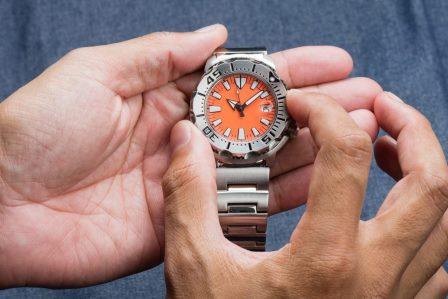The rotating bezel is the most characteristic component of a dive watch. Despite its simple function, a timepiece must have a timing bezel to be considered a real dive watch.
So what is the rotating bezel’s role in diving? Let’s find out now!
Exact timing is crucial to scuba divers because their oxygen supply is always limited. It’s very dangerous not to know how much time has elapsed underwater. Therefore, the rotating bezel on dive watches is a reminder to prevent divers from exceeding their diving time limit.
Basically, we can use the rotating bezel in two ways
Measuring elapsed time
Very simple!
- Rotate the bezel to point the lumed pip against the minute hand.
- The minute hand continues to move on, and the gap between it and the lumed pip indicates how much time has just passed. If the minute hand points at the 20 position on the bezel, you have been diving for 20 minutes.
Measuring remaining time
Scuba divers use the bezel this way more often!
- Determine your bottom time, for example, 35 minutes
- Follow this formula: 60 – bottom time (60 – 35 = 25)
- Rotate the bezel till the 25 position lines up with the minute hand.
- If you did correctly, the minute hand now takes 35 minutes to reach the lumed pip’s position. The gap between them indicates your remaining bottom time, don’t overpass it.
You will notice that the first 10 – 25 minutes on the bezel are often displayed in a more detailed and highlighted way than the rest! Why? This is derived from Rolex’s design on their 1950s classic diving watches. The bezel’s highlighted first quarter measures the ascent time of the diver, so this area should be more detailed than the rest.
This “count-down” bezel was quite helpful in military underwater tasks then, but it seems obsolete for today’s diving.
In terms of construction, there are two types of rotating bezels:
Internal bezel
The bezel is installed under the crystal. This design gives your dive watch a dressier appearance because it looks no different from a regular dress watch at first glance. It’s usually a bidirectional bezel you can operate through an other crown. This type of rotating bezel is not broadly used due to some disadvantages:
- Difficult to operate: divers usually set the bezel after wearing a wet suit with diving gloves, so a small crown is too difficult to grip and turn single-handedly.
- Complex texture: internal bezel, which is remotely controlled, is more complicated than the external bezel, which can be directly operated on the watch face.
- Additional open on the watch case: A dive watch’s body should be as leak-free as possible, and the easiest way for water to get inside is through the crowns. One more crown means one more potential open on the case.
External bezel
That is the type of rotating bezel you can see on most dive watches in any price range, from affordable to luxury. In my opinion, it’s much more practical than an internal bezel:
- Easy to operate single-handedly: it’s much easier to directly grip and turn the bezel edge than to operate it through a small crown remotely.
- Easy to repair or replace: an external bezel can be disassembled & installed with ease. If you need to fix or replace your watch’s external bezel, it would cost you much less money and effort than an internal one.
Despite some inevitable shortcomings, such as getting jammed by sand and debris or wearing out through daily use, the external bezel still has many advantages over the internal bezel.
Most external bezels are unidirectional (counterclockwise-rotating) due to safety. An accidental move of the bezel would change the gap between the minute hand and the lumed pip. This leads to losing track of remaining time, and it’s safer if the bezel unexpectedly shortens
the remaining time instead of lengthening it.
It’s worth noting that some diving-style timepieces still feature a bidirectional bezel. Still, they are just desk divers or vintage diving pieces (the old Rolex Submariner 5513, for example). An accurate contemporary dive watch should feature a one-way rotating bezel.
Related Posts:

Leave a Reply